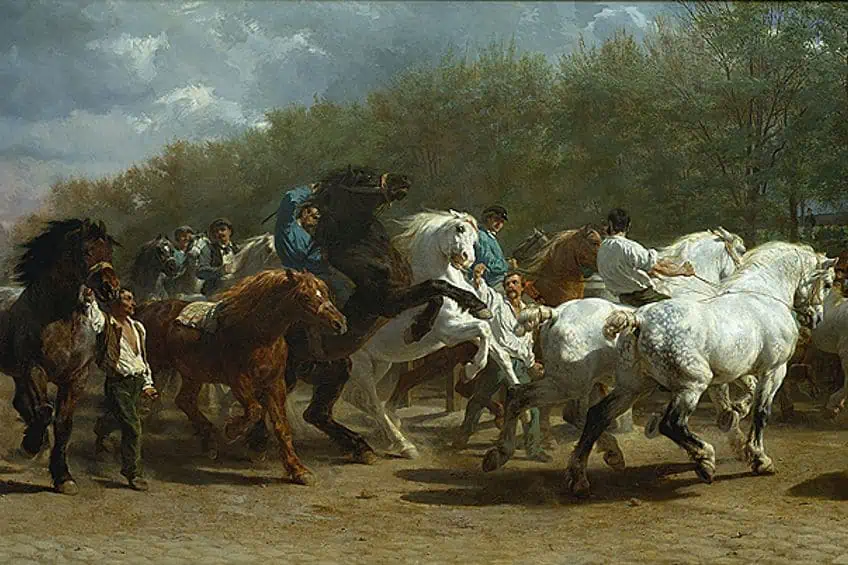Famous Horse Paintings – Explore the Most Famous Horses in Art
Horses are one of the most loved animals on the planet and have always held a special place in the hearts of many famous artists. Horses in the art are featured more often than you might think! In this article, we will explore the different famous horse paintings from art history that have become some of the most iconic paintings of horses by famous artists. From battle scenes to equestrian portraits, these beautiful creatures will surely leave a lasting impression on you!
Contents
- 1 The Symbolism of Horses in Art History
- 2 Top 10 Most Famous Horse Paintings
- 2.1 Chinese Horse (15,000 – 13,000 BCE) at Lascaux Cave
- 2.2 The Battle of Anghiari (1504 – 1505) by Leonardo da Vinci and Peter Paul Rubens
- 2.3 Saint Martin and the Beggar (1597 – 1599) by El Greco
- 2.4 Whistlejacket (1762) by George Stubbs
- 2.5 Napoleon Crossing the Alps (1801) by Jacques-Louis David
- 2.6 Horse Frightened by Lightning (1825 – 1829) by Eugène Delacroix
- 2.7 The Horse Fair (1852 – 1855) by Rosa Bonheur
- 2.8 Blue Horse I (1911) by Franz Marc
- 2.9 A Start at Newmarket (1937) by Sir Alfred Munnings
- 2.10 Galloping Horse (1953) by Xu Beihong
- 3 Frequently Asked Questions
The Symbolism of Horses in Art History
The history of horses in art can be seen across most of the visual arts and was even part of important archaeological discoveries that included the first forms of figurative sculpture in the world. Horses held many roles in human history, from racehorses to creatures of inspiration and potent symbols of freedom and power, the horse has a dynamic breadth of character. It is, therefore, not surprising that the horse as a subject in art and painting was quite popular for a select few. Horses in fine art made their appearance as early as the 14th century in the context of the Renaissance period. Some of the most prolific painters included the equestrian genre in their list of great areas of exploration and include artists like Titian, Paolo Uccello, and Leonardo da Vinci.
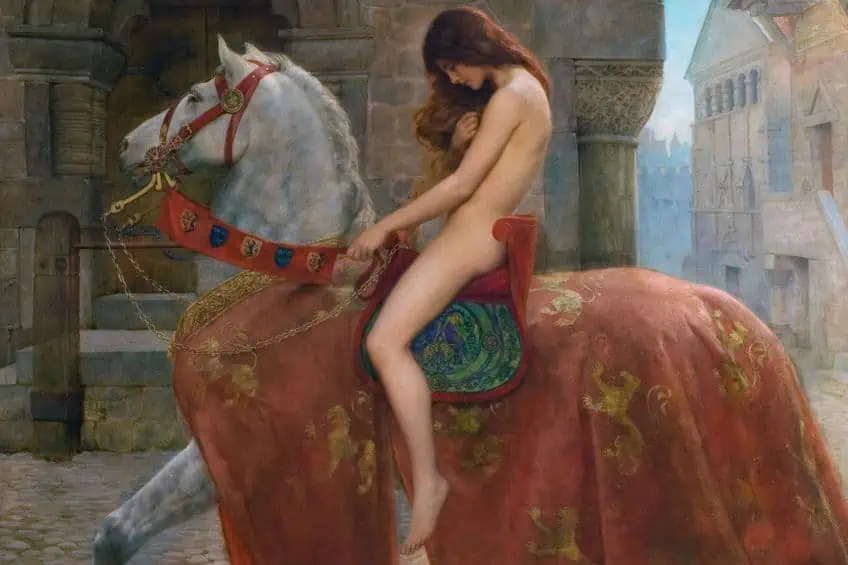
By the time the Baroque style emerged on the European art scene, the sub-genre of equestrian portraiture became a niche subject and attracted painters such as Anthony van Dyck and Sir Peter Paul Rubens. With the dawn of Romanticism, paintings of horses saw the introduction of more expressive, idealistic, and Romantic approaches, which broadened the ways that the genre of horse painting could be adopted and repurposed for added symbolism.
Top 10 Most Famous Horse Paintings
Below, we will explore some of the most famous paintings of horses by famous artists that illustrate the cheerful, powerful, and peculiar-looking creatures that will inspire you to include a horse or two in your next painting!
Chinese Horse (15,000 – 13,000 BCE) at Lascaux Cave
| Artist | Unknown |
| Date | 15,000 – 13,000 BCE |
| Medium | Mineral pigments and charcoal on a cave wall |
| Dimensions (cm) | Unavailable |
| Where It Is Housed | Lascaux, Montignac, France |
This Chinese Horse painting was first discovered in 1940 at one of the world’s most popular prehistoric cave art sites, Lascaux, in France. The painting earned its name for bearing resemblance to the style of a Sung Chinese painting of a horse and was painted between 15,000 and 13,000 BCE using various mineral pigments. According to archaeologists, these early artists crafted their own paintbrushes from animal skin and hair and also employed a spray painting technique using a hollow reed, which would be used to blow pigment through. Lascaux has been declared a UNESCO World Heritage Site since 1979 and contains some of the most beautiful parietal paintings and engravings from our early ancestors.
As such, horses were definitely favored among early artists since they also featured figurines carved with ivory bone in Germany.
The Battle of Anghiari (1504 – 1505) by Leonardo da Vinci and Peter Paul Rubens
| Artist | Leonardo di ser Piero da Vinci (1452 – 1519) and Sir Peter Paul Rubens (1577 – 1640) |
| Date | 1504 – 1505 |
| Medium | Charcoal and chalk on paper |
| Dimensions (cm) | Unavailable |
| Where It Is Housed | The Louvre Museum, Paris, France |
This is by far the most interesting example of horses in art history and painting since the actual painting was found to not exist. How so? What remains of the alleged horse painting are preparatory sketches and a copy of The Battle of Anghiari by Sir Peter Paul Rubens. The painting was initially a joint project by both Leonardo da Vinci and Rubens who seemed to have planned the painting around a battle scene featuring four men on four war horses while engaging in battle to obtain a heraldic flag at the 1440 Battle of Anghiari. Rubens’ copy of the planned painting represents a sketch of what would have been an interesting emotive painting. The preparatory drawing by Rubens remains at the Louvre Museum in Paris and is the last complete image one might have to imagine what the original might have looked like.
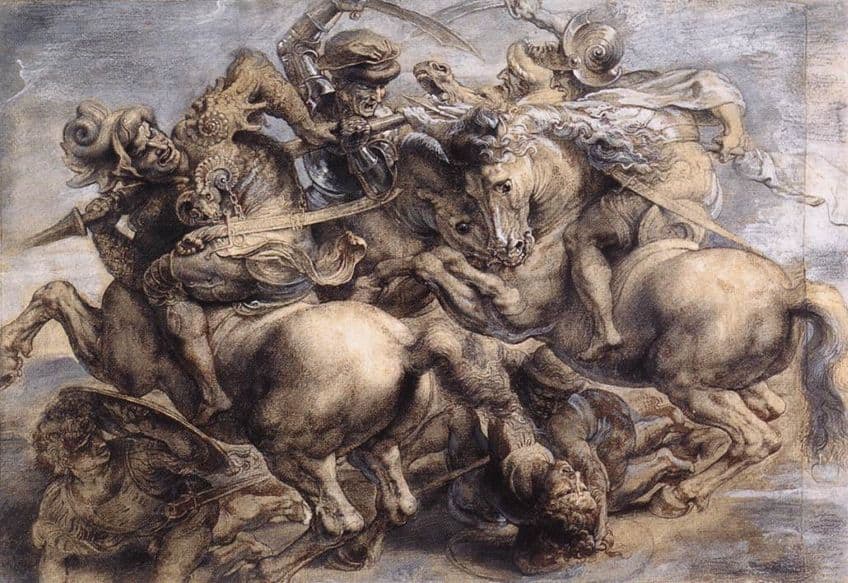
Saint Martin and the Beggar (1597 – 1599) by El Greco
| Artist | Domḗnikos Theotokópoulos (known as “El Greco”) (1541 – 1614) |
| Date | 1597 – 1599 |
| Medium | Oil on canvas |
| Dimensions (cm) | 194 x 103 |
| Where It Is Housed | The National Gallery of Art, Washington D.C., United States |
This famous Mannerist horse painting was created by a Greek painter of the Spanish Renaissance, El Greco. Saint Martin and the Beggar illustrates a scene where the saint cuts off a piece of his cloak to help the beggar beside him. The saint is also seated on a noble white steed and shows an emphasis on the horse’s long legs, which was characteristic of the trend in figure painting at the time.
Saint Martin of Tours bears a very pious expression on his face as he helps those who are unable to help themselves.
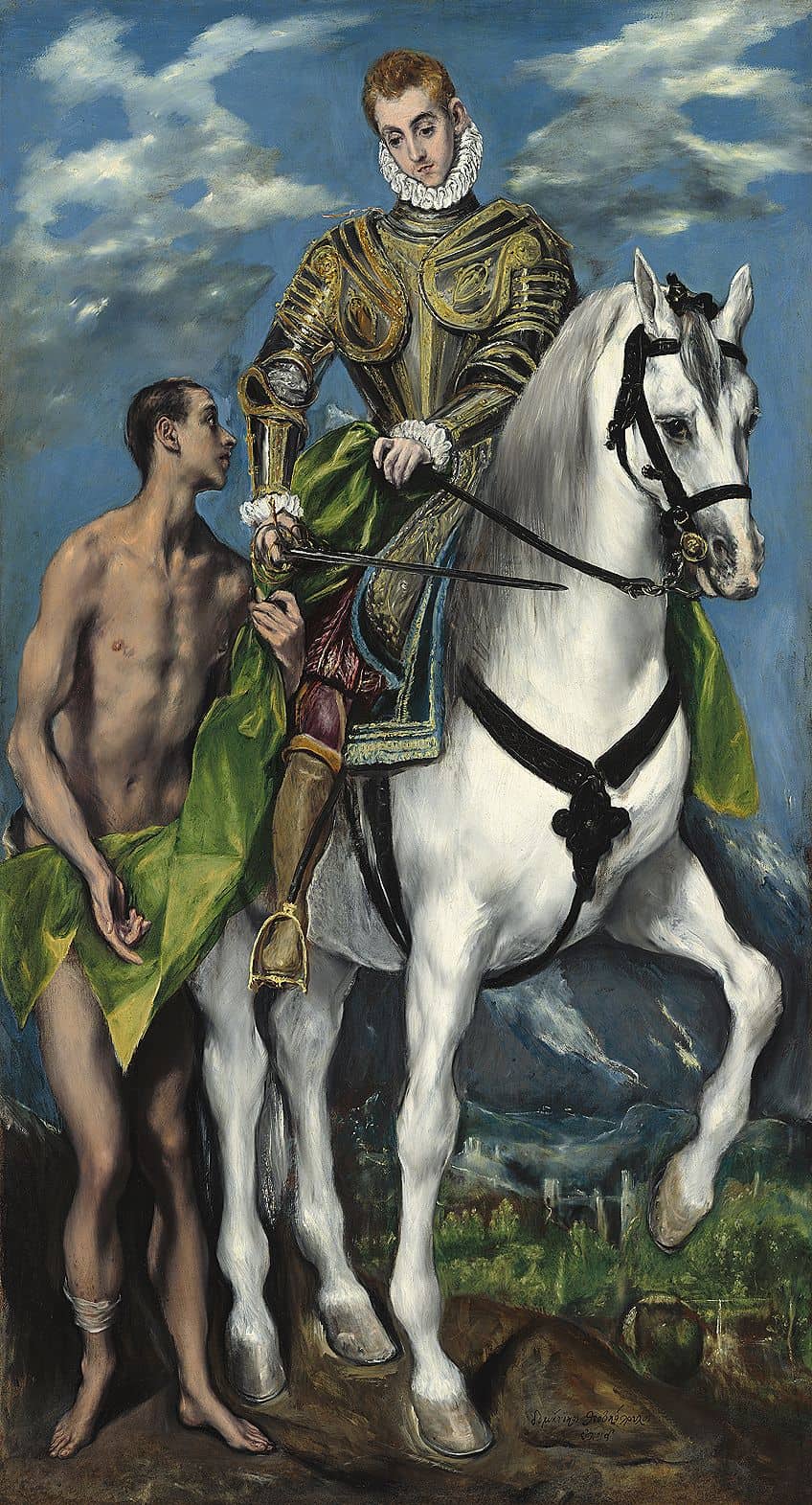
Whistlejacket (1762) by George Stubbs
| Artist | George Stubbs (1748 – 1825) |
| Date | 1762 |
| Medium | Oil on canvas |
| Dimensions (cm) | 292 x 246 |
| Where It Is Housed | The National Gallery, London, United Kingdom |
Whistlejacket is one of the most famous equestrian paintings of the 18th century created by George Stubbs. Stubbs was a famous English horse painting artist who gained a significant amount of recognition for his many equestrian-inspired paintings. Whistlejacket portrays the racehorse of the Marquess of Rockingham on a full life-sized scale against a neutral background. The horse itself was described by The Independent as a “flawless beauty of an Arabian thoroughbred” and the painting was acquired by the London National Gallery for what would now equate to $13 million.

One of the most unique features of this equestrian painting is that it does not situate the horse in any particular location and does not seem to present itself as simply a study of equestrian anatomy. Rather, the horse portrait focuses solely on the details and character of the horse in question, belonging to Charles Watson-Wentworth, the second Marquess of Rockingham. In a way, Stubbs captures the essence of the spirit of the horse that alludes to freedom of spirit, not tied to any background or environment, which makes this horse painting quite special for its time.
Napoleon Crossing the Alps (1801) by Jacques-Louis David
| Artist | Jacques-Louis David (1748 – 1825) |
| Date | 1801 |
| Medium | Oil on canvas |
| Dimensions (cm) | 260 x 221 |
| Where It Is Housed | Musée national du château de Malmaison, Rueil-Malmaison, France |
Among the many paintings of horses by famous artists, this famous horse painting depicts the notorious Napoleon Bonaparte on his majestic steed and is one of the world’s most recognized horse paintings. The painting is from a series of horse paintings commissioned by the King of Spain and created between 1801 and 1805. The painting represents an idealized version of the historical event at the Great St. Bernard Pass in 1800 where Napoleon crossed the Alps with his army. The painting was created by Jacques-Louis David who was a popular Neoclassical painter that specialized in history painting. David was known to be somewhat of an arts dictator under the French Republic and was also acquainted with one of the most controversial French Revolutionist figures, Maximilien Robespierre.
David portrays Napoleon’s Arab stallion as completely under the control of its rider with the wind propelling the duo in an upward direction, as though the forces of nature were with Napoleon.
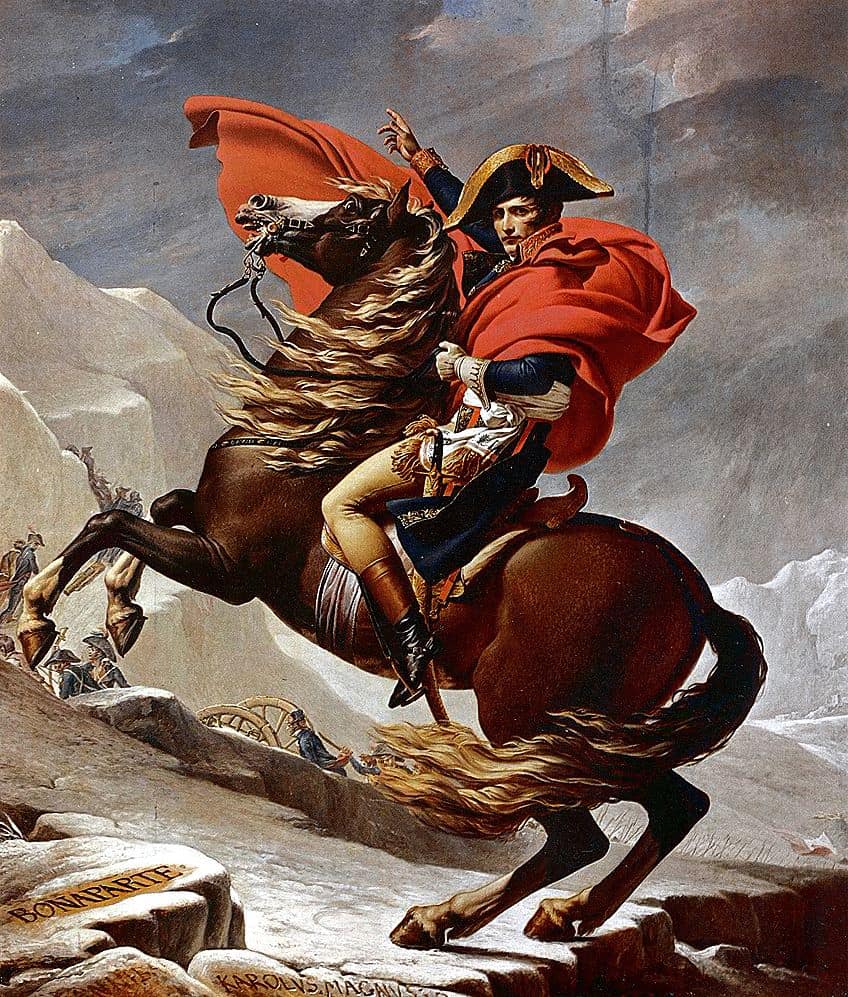
Horse Frightened by Lightning (1825 – 1829) by Eugène Delacroix
| Artist | Ferdinand Victor Eugène Delacroix (1798 – 1863) |
| Date | 1825 – 1829 |
| Medium | Watercolor |
| Dimensions (cm) | Unavailable |
| Where It Is Housed | Museum of Fine Arts, Budapest, Hungary |
Horse Frightened by Lightning is one of the most expressive horse paintings of the 19th century created by French Romantic painter Eugène Delacroix between 1825 and 1829. The painting was executed in watercolor and portrays a horse amid a storm with an intense facial expression. The horse seems frightened by the rumbling lightning as one might imagine the storm to be incredibly terrifying. The inclement weather is highlighted by the strong contrast created between the horse and the gloomy black and gray clouds that cover the entire sky. There is not a glimmer of sunshine and perhaps the horse almost appears to have encountered a lightning bolt in front of himself as his body is illuminated by an unknown source of light. The symbolism embedded in most Romantic horse paintings includes themes of untamed passion, power, nobility, and intense emotion. An exaggeration of emotion was a common feature of most Romantic paintings at the time.
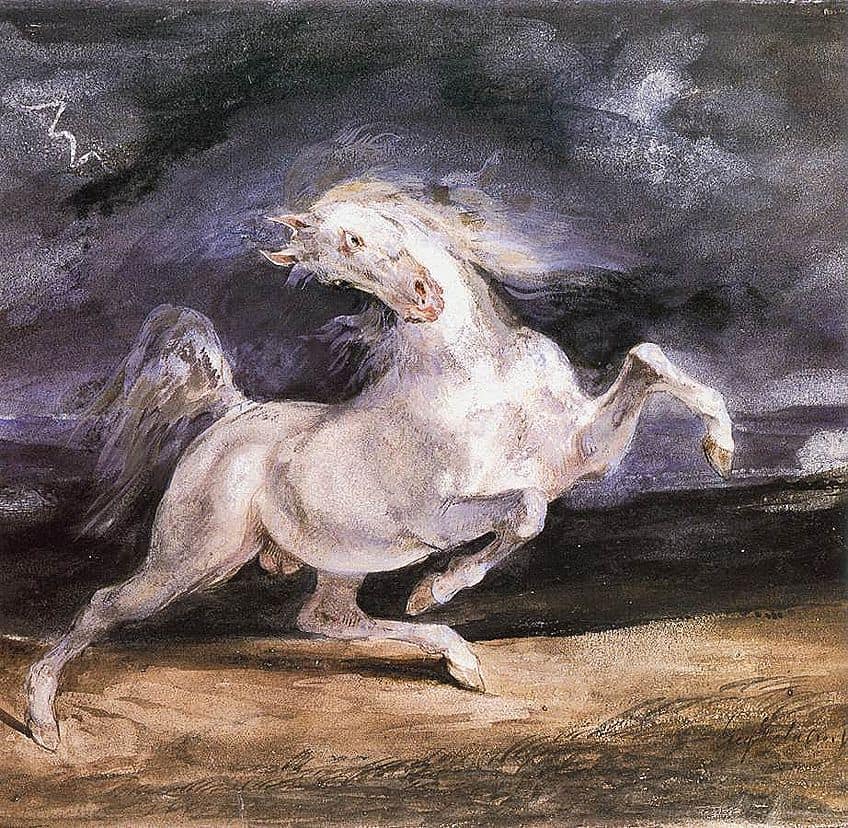
The Horse Fair (1852 – 1855) by Rosa Bonheur
| Artist | Marie-Rosalie Bonheur (1822 – 1899) |
| Date | 1852 – 1855 |
| Medium | Oil on canvas |
| Dimensions (cm) | 244.5 x 506.7 |
| Where It Is Housed | The Metropolitan Museum of Art, New York City, United States |
Rosa Bonheur was one of the most famous femme French painters who created this famous $1.4 million horse painting. The painting illustrates a horse market at the Boulevard de l’Hôpital in Paris with a view of the asylum of Salpêtrière in the background. Bonheur was incredibly dedicated to her profession and spent around a year perfecting her preliminary sketches for this painting. Interestingly so, she was also not one to shy away from risk and chose to disguise herself as a man to sneak into these areas and conduct her artistic business as usual. Bonheur gained plenty of recognition for her animal paintings, especially after The Horse Fair debuted at the Paris Salon in 1853.
The artist referred to The Horse Fair as her own “Parthenon frieze” and demonstrates her belief in her own talents and perseverance in pursuing her passions in “a man’s world”.
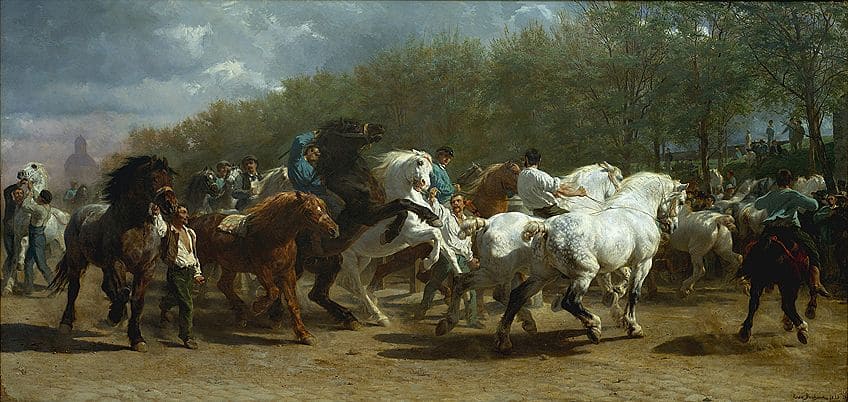
Blue Horse I (1911) by Franz Marc
| Artist | Franz Moritz Wilhelm Marc (1880 – 1916) |
| Date | 1911 |
| Medium | Oil on canvas |
| Dimensions (cm) | 112 x 84.5 |
| Where It Is Housed | Städtische Galerie im Lenbachhaus und Kunstbau, Munich, Germany |
This famous Expressionist horse painting was created by one of the most famous German Expressionist artists, Franz Marc. Blue Horse I portrays a gentle-looking horse executed in shades of light pastel blue with sharper, bold indigo contours that express the regal yet spiritual nature of the color and the horse. The painting also contains a colorful background that reminds one of the colorful symbolic nature of Marc’s paintings with blue representing masculinity and spirituality while red stands for the primal nature of the world, and yellow as the feminine quality. Altogether, the painting symbolizes the spiritual fight and triumph against the material world.
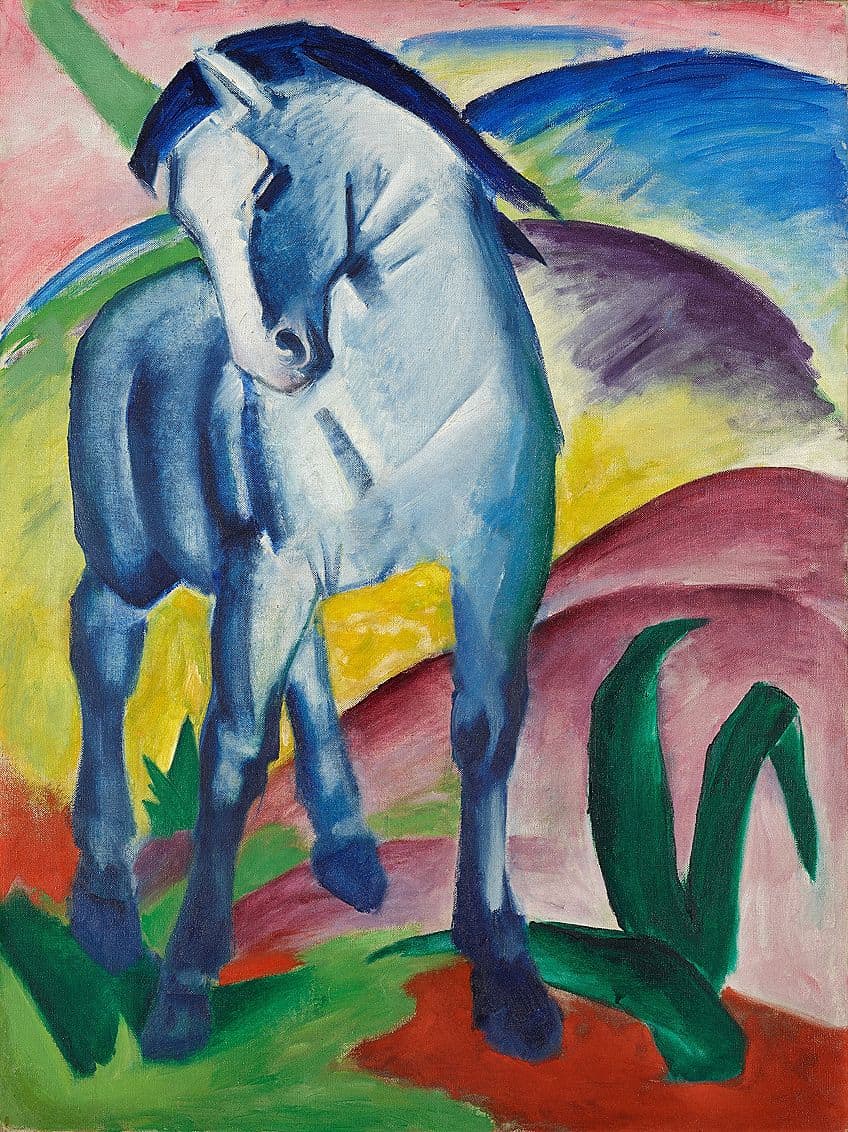
A Start at Newmarket (1937) by Sir Alfred Munnings
| Artist | Sir Alfred Munnings (1878 – 1959) |
| Date | 1937 |
| Medium | Oil on panel |
| Dimensions (cm) | 45 x 54.6 |
| Where It Is Housed | Private collection |
A Start at Newmarket is one of the most famous equestrian racehorse paintings that was created by one of England’s best horse painting artists, Sir Alfred Munnings. Munnings gained fame for his striking horse paintings and began his exploration of equestrian portraits from his childhood days. Raised in Suffolk, the artist was often surrounded by these majestic creatures and as such, he studied their anatomy via sketches. In A Start at Newmarket, Munnings draws our attention to the start of a race that captures the spark at which each rider takes charge alongside the way that each horse reacts. The start of a horse race is a fascinating moment to capture and is further romanticized by Munnings.
The energy that surrounds the painting includes a moment of stillness that one experiences as the viewer and imagined “audience” of an actual horse race where the anticipation of the start of an exhilarating race ensues.
Galloping Horse (1953) by Xu Beihong
| Artist | Xu Beihong (also known as “Ju Péon”) (1895 – 1953) |
| Date | 1953 |
| Medium | Ink on paper |
| Dimensions (cm) | 49.3 x 52.7 |
| Where It Is Housed | China Modern Contemporary Art Document, Beijing, China |
Xu Beihong is one of the most prolific Chinese horse painting artists who was most famous for his ink horse and bird paintings. His work reflected a modern approach to traditional Chinese ink painting and was also celebrated as one of the great academy presidents of Chinese Modern art. Xu Beihong had a comprehensive understanding of horse anatomy and knew exactly how to depict a horse from almost any angle. Galloping Horse is one of his most famous horse paintings that depicts a horse racing through an invisible landscape with the landscape imagined to be an open field of sorts as illustrated by the horse’s mane that blows against the wind. One of the most identifiable characteristics of Xu Beihong’s works is his careful placement of ink splotches and layering of ink such that it creates an interesting balance in tone without making the horse appear as an illustration, rather, as a painting. The high spirit of a horse is what Xu Beihong intended to express, especially since it was created during a period of peril in China and the horse served as a symbol of tenacity and strength.
The characters of these graceful and expressive equestrian creatures have definitely left an impression on artists throughout the centuries. We hope that you have enjoyed browsing and learning more about the ways that artists have represented horses and used them as symbols to relay deeper messages.
Frequently Asked Questions
What Is Equestrian Portraiture?
Equestrian portraiture refers to a genre of painting that depicts the owner of a horse or subject on horseback. Equestrian portraits are often executed for individuals of high status and elevate the social standing of a person. Often, people of a noble, royal, or aristocratic society would request artists to paint an equestrian portrait, thus equating horses with nobility, royalty, and power.
Who Is the Most Famous Horse Painter?
The most famous horse painter is considered to be George Stubbs. George Stubbs was a popular English painter who gained much recognition from his mastery of horse painting and was a self-taught artist.
What Do Horses Symbolize in Art?
In many paintings, horses symbolize power, nobility, and freedom of spirit. Horses may also symbolize restlessness, strength, endurance, and the momentum of life.
Nicolene Burger, a South African multimedia artist and creative consultant, specializes in oil painting and performance art. She earned her BA in Visual Arts from Stellenbosch University in 2017. Nicolene’s artistic journey includes exhibitions in South Korea, participation in the 2019 ICA Live Art Workshop, and solo exhibitions. She is currently pursuing a practice-based master’s degree in theater and performance. Nicolene focuses on fostering sustainable creative practices and offers coaching sessions for fellow artists, emphasizing the profound communicative power of art for healing and connection. Nicolene writes blog posts on art history for artfilemagazine with a focus on famous artists and contemporary art.
Learn more about Nicolene Burger and about us.
Cite this Article
Nicolene, Burger, “Famous Horse Paintings – Explore the Most Famous Horses in Art.” artfilemagazine – Your Online Art Source. February 9, 2023. URL: https://artfilemagazine.com/famous-horse-paintings/
Burger, N. (2023, 9 February). Famous Horse Paintings – Explore the Most Famous Horses in Art. artfilemagazine – Your Online Art Source. https://artfilemagazine.com/famous-horse-paintings/
Burger, Nicolene. “Famous Horse Paintings – Explore the Most Famous Horses in Art.” artfilemagazine – Your Online Art Source, February 9, 2023. https://artfilemagazine.com/famous-horse-paintings/.


